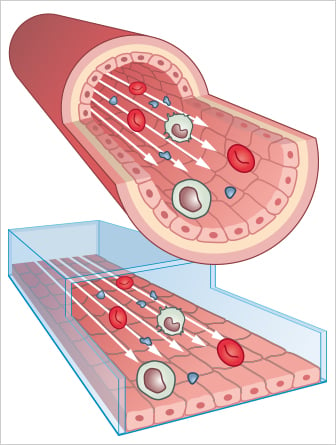Why Cell Culture Under Flow?
Liquids are a crucial component of every living species. Many cell types are surrounded by moving fluids. Examples are:
- vascular endothelial cells that form the inner layer of blood vessels,
- lymphatic endothelial cells that form the inner layer of lymphatic vessels,
- epithelial cells of the kidney and the lung.
This liquid flow causes shear stress, a mechanical force that influences the cell morphology and behavior in many ways.
In many standard in vitro experiments, cells are cultured without flow. Under these static conditions, shear stress-dependent cellular changes cannot be taken into account. In contrast, in vitro cell culture under flow simulates this mechanical stimulus and induces a more physiological, in vivo-like behavior.
Working under flow conditions can be especially important when using cells that occur in biofluidic systems, such as endothelial or epithelial cells.
ibidi Blog Articles |
Are you curious about 3 Reasons Why You Should Cultivate Endothelial Cells Under Flow? Get a concise overview in the ibidi Blog.
Discover how cell culture under flow is used to simulate endothelial dysfunction in our blog article ”Shear Genius: Microfluidics in Atherosclerosis Research”.

Endothelial cells in blood vessels (top) are under continuous flow. Using in vitro cell culture under flow (bottom), these physiological conditions can be simulated.
Shear stress is the mechanical force induced by the friction of liquid against the apical cell membrane. In vivo, several adherent cell types are exposed to mechanical shear stress in biofluidic systems, such as blood and lymphatic vessels or nephrons. This mechanical stimulus has a great impact on the physiological behavior and adhesion properties of cells. Cells react to shear stress by changes in ion channel activation, gene expression, and reorganization of the whole cell layer.
The shear stress is measured in dyne/cm² (dyn/cm²). Physiological shear stress values range from 0.5 to 120 dyn/cm² and depend on the vessel type (e.g., artery or vein), the tissue (e.g., brain, connective tissue, or heart), and the size of the organism (e.g., mouse, rat, or human).



Human umbilical vein endothelial cells (HUVEC) cultured under flow conditions (20 dyn/cm²) in a µ-Slide I 0.4 Luer over 9 days. The primary cells were transduced with an adenoviral LifeAct vector 24 hours prior to the experiment.
| Vessel | Shear stress (dyn/cm²) | Reference |
| Aorta | ∼ 1–22 | C.P. Cheng, R.J. Herfkens, C.A. Taylor. Comparison of abdominal aortic hemodynamics between men and women at rest and during lower limb exercise. J Vasc Surg, 2003, 10.1067/mva.2002.107 read abstract |
| Arteries | ∼ 10–70 | C.P. Cheng, R.J. Herfkens, C.A. Taylor. Abdominal aortic hemodynamic conditions in healthy subjects aged 50-70 at rest and during lower limb exercise: in vivo quantification using MRI. Atherosclerosis, 2003, 168(2):323–31 read abstract |
| Veins | ∼ 1–6 | A.M. Malek, S.L. Alper, S. Izumo. Hemodynamic shear stress and its role in atherosclerosis. JAMA, 1999, 282(21):2035–42 read abstract |
| Capillaries | ∼ 3–95 | A.G. Koutsiaris, et al. Volume flow and wall shear stress quantification in the human conjunctival capillaries and post-capillary venules in vivo. Biorheology, 2007, 44(5–6):375–86 read abstract |
Read on and learn more about the Different Types of Flow.




